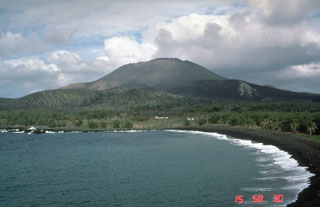Report on Pagan (United States) — August 1993
Bulletin of the Global Volcanism Network, vol. 18, no. 8 (August 1993)
Managing Editor: Edward Venzke.
Pagan (United States) Eruptive activity declines in August; several lahars
Please cite this report as:
Global Volcanism Program, 1993. Report on Pagan (United States) (Venzke, E., ed.). Bulletin of the Global Volcanism Network, 18:8. Smithsonian Institution. https://doi.org/10.5479/si.GVP.BGVN199308-284170
Pagan
United States
18.13°N, 145.8°E; summit elev. 570 m
All times are local (unless otherwise noted)
Eruptive activity from the summit crater continued at North Pagan in June and July with ejection of tephra columns to heights of several kilometers. Eruptive pulses, 30-60 minutes long, were occurring several times each day during this period. Activity declined in late July, and had not increased again as of early September. There have been no reports of lava flows, but several lahars have descended the SE flank of the cone. Most morphological changes observed in early September resulted from these continuing lahars. Seismicity was also at a low level in early September.
Geological Summary. Pagan Island, the largest and one of the most active of the Mariana Islands volcanoes, consists of two stratovolcanoes connected by a narrow isthmus. Both North and South Pagan stratovolcanoes were constructed within calderas, 7 and 4 km in diameter, respectively. North Pagan at the NE end of the island rises above the flat floor of the northern caldera, which may have formed less than 1,000 years ago. South Pagan is a stratovolcano with an elongated summit containing four distinct craters. Almost all of the recorded eruptions, which date back to the 17th century, have originated from North Pagan. The largest eruption during historical time took place in 1981 and prompted the evacuation of the sparsely populated island.
Information Contacts: D. Shackelford, Fullerton, CA; R. Chong, Disaster Control Office, Saipan.

